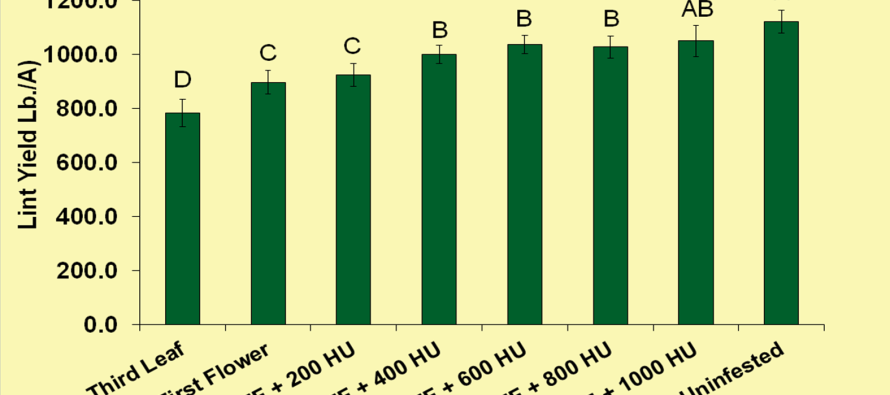Terminating Spider Mite Applications in Cotton

When to terminate spider mite treatments can be a very difficult decision this time of year. Spider mites can cause yield loss directly by feeding on small squares and bolls causing them to abort, or indirectly by feeding on leaves which reduces photosynthesis not allowing bolls to fill out correctly. In many ways this indirect damage would be very similar to defoliation.
It is difficult to go in any cotton field right now and not find spider mites at some level, but the question is when are we far enough along to let them go. Traditionally we have said we need to protect from spider mites out 600-650 heat units past NAWF 5 (cutout). With the heat units we are accumulating now that would be about 24-26 days past cutout. This should be more than enough time to protect fruit with no yield penalty.
Here are a few things to think about taken from the famous publication by Johnie Jenkins and Jack McCarty “Useful Tools in Managing Cotton Production: End of Season Plant Mapsâ€. The probability of opening the uppermost first position boll in the terminal on a full season variety is 4.8% and 0.3% on an early season variety. If you defy the odds and get it to open, it will be worth $3.00/Acre. You cannot justify spending money to try and protect this position (I hope you get it, but there is no way you can come out ahead trying to protect it). The probability of opening the first position boll 2 nodes down from the terminal on a full season variety is 15.1% and 3.9% on an early season variety. If you defy the odds and get it to open, it will be worth $11.00 and $8.00 per Acre, respectively. The probability of opening the first position boll 3 nodes down from the terminal on a full season variety is 26.4% and 9.0% on an early season variety. If you open this position it will be worth $21.00 and $22.00 per Acre, respectively. Protecting this position more than pays for product and application costs. The upper most first position boll alone will not justify protecting and the second first position down from the terminal likely will not either. The point I am trying to make is let’s do things that have an economic advantage and realize our limitations. One of the things we are dealing with this year is a large fruiting gap due to some excessive rain events in July and we are trying to fill more of the top out. I completely agree with this but there is a point where it will not pay you back.
The Mid-South Entomology Working Group (MSEWG) has worked extremely hard over the last few years to better refine thresholds for spider mites in cotton. One of the studies we conducted was artificially infesting mites at a fixed time period to better understand yield loss potential. Early season infestations prior to bloom caused the most yield loss but we saw significant differences in cotton yields from plots with no mites out to 800 heat units past first flower (32-40 days) (not 800 heat units past cut out). This would be short of our current recommendations of 600-650 heat units past cutout, however, these were irrigated, heavily managed plots. Yield loss could possibly extend much further on non-irrigated or stressed cotton. In fact, a few years ago we measured yield loss from spider mites from an irrigated and non-irrigated field in the delta when the infestation originated around mid-bloom. In the non-irrigated field yield loss was nearly 50% and only 10% yield loss in the irrigated field comparing areas with spider mites to areas without spider mites with similar damage levels.
There likely will not be a clear cut scenario for spider mite termination from the fields I have been walking. You are going to have to take it field by field and base your decision on infestation level, weather forecast, realistic harvestable boll goal, and crop phenology. We will be glad to help if you have any questions, just give one of us a call.





Let me tell You a sad story ! There are no comments yet, but You can be first one to comment this article.
Write a comment